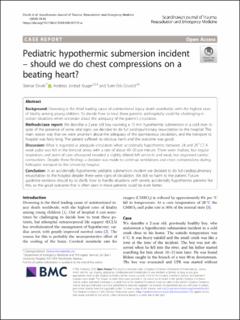| dc.contributor.author | Einvik, Steinar | |
| dc.contributor.author | Krüger, Andreas | |
| dc.contributor.author | Gisvold, Sven Erik | |
| dc.date.accessioned | 2021-03-22T12:21:42Z | |
| dc.date.available | 2021-03-22T12:21:42Z | |
| dc.date.created | 2020-08-21T11:33:27Z | |
| dc.date.issued | 2020 | |
| dc.identifier.issn | 1757-7241 | |
| dc.identifier.uri | https://hdl.handle.net/11250/2734830 | |
| dc.description.abstract | Background: Drowning is the third leading cause of unintentional injury death worldwide, with the highest rates of fatality among young children. To decide how to treat these patients prehospitally could be challenging in certain situations when uncertain about the adequacy of the patent’s circulation. Methods/case report: We describe a 2 year old boy surviving a 15 min hypothermic submersion in a cold river. In spite of the presence of some vital signs, we decided to do full cardiopulmonary resuscitation to the hospital. The main reason was that we were uncertain about the adequacy of the spontaneous circulation, and the transport to hospital was fairly long. The patient suffered no obvious harm and the outcome was good. Discussion: What is regarded as adequate circulation when accidentally hypothermic between 24 and 250 C? A weak pulse was felt in the femoral artery with a rate of about 40–50 per minute. There were shallow, but regular respiration, and point of care ultrasound revealed a slightly dilated left ventricle and weak, but organised cardiac contractions. Despite these findings a decision was made to continue ventilations and chest compressions during helicopter transport to the University hospital. Conclusion: In an accidentally hypothermic pediatric submersion incident we decided to do full cardiopulmonary resuscitation to the hospital despite there were signs of circulation. We did no harm to the patient. Future guideline revisions should try to clarify how to handle situations with severly accidentally hypothermic patients like this, so the good outcome that is often seen in these patients could be even better | en_US |
| dc.language.iso | eng | en_US |
| dc.publisher | BMC | en_US |
| dc.rights | Navngivelse 4.0 Internasjonal | * |
| dc.rights.uri | http://creativecommons.org/licenses/by/4.0/deed.no | * |
| dc.title | Pediatric hypothermic submersion incident – should we do chest compressions on a beating heart? | en_US |
| dc.type | Peer reviewed | en_US |
| dc.type | Journal article | en_US |
| dc.description.version | publishedVersion | en_US |
| dc.source.journal | Scandinavian Journal of Trauma, Resuscitation and Emergency Medicine | en_US |
| dc.identifier.doi | https://doi.org/10.1186/s13049-020-00779-w | |
| dc.identifier.cristin | 1824462 | |
| dc.description.localcode | © The Author(s). 2020 Open Access This article is licensed under a Creative Commons Attribution 4.0 International License, which permits use, sharing, adaptation, distribution and reproduction in any medium or format, as long as you give appropriate credit to the original author(s) and the source, provide a link to the Creative Commons licence, and indicate if changes were made. The images or other third party material in this article are included in the article's Creative Commons licence, unless indicated otherwise in a credit line to the material. If material is not included in the article's Creative Commons licence and your intended use is not permitted by statutory regulation or exceeds the permitted use, you will need to obtain permission directly from the copyright holder. To view a copy of this licence, visit http://creativecommons.org/licenses/by/4.0/. The Creative Commons Public Domain Dedication waiver (http://creativecommons.org/publicdomain/zero/1.0/) applies to the data made available in this article, unless otherwise stated in a credit line to the data. | en_US |
| cristin.ispublished | true | |
| cristin.fulltext | original | |
| cristin.qualitycode | 1 | |

